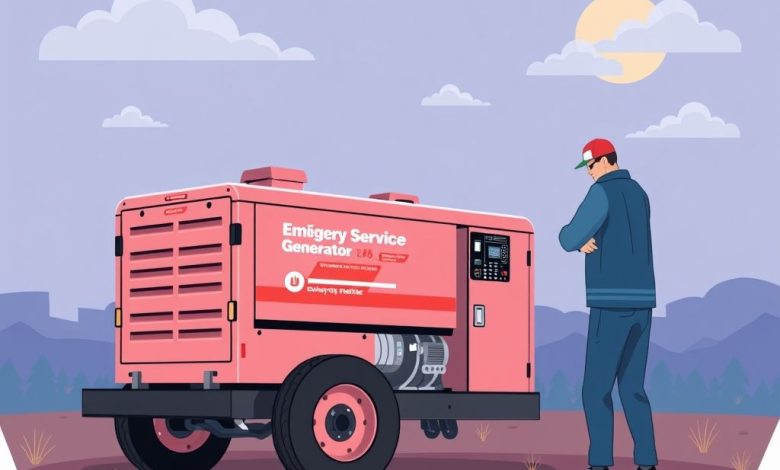Field Service Management for Emergency Generator Checks

Introduction
Field Service Management (FSM) is a critical component of any organization’s operations, particularly when it comes to emergency generator checks. These systems provide backup power during outages, ensuring business continuity and safety. Effective FSM strategies are essential for maintaining generators in optimal condition, minimizing downtime, and preventing costly repairs.
Importance of Regular Emergency Generator Checks
Regular maintenance is crucial for emergency generators to function properly during critical situations. Neglecting routine checks can lead to unexpected failures, leaving businesses vulnerable to extended power outages. Some key reasons why regular checks are vital include:
- Ensuring system reliability
- Extending equipment lifespan
- Preventing costly repairs
- Maintaining compliance with industry regulations
Common Issues During Emergency Generator Checks
During routine inspections, technicians often encounter various issues that require attention. Some common problems include:
- Low oil levels
- Corroded connections
- Faulty circuit boards
- Clogged air filters
- Malfunctioning starters
Addressing these issues promptly helps prevent more severe complications and ensures the generator remains operational when needed most.
Implementing an Effective Field Service Management Strategy
A well-designed FSM approach can significantly enhance emergency generator management. Here are some best practices to consider:
- Create detailed checklists
- Utilize mobile technology for real-time updates
- Implement a robust scheduling system
- Conduct regular training sessions for technicians
- Maintain accurate records of all maintenance activities
By implementing these strategies, organizations can streamline their FSM processes, improve efficiency, and ensure consistent quality of service.
Leveraging Technology in Field Service Management
Modern FSM solutions incorporate cutting-edge technologies to optimize emergency generator checks. Some innovative tools include:
- Mobile apps for remote monitoring
- Augmented reality for visual diagnostics
- Predictive analytics for proactive maintenance
- Artificial intelligence for automated scheduling
These technological advancements enable faster response times, improved accuracy, and enhanced overall performance of FSM operations.
Best Practices for Emergency Generator Maintenance
To maintain emergency generators effectively, consider the following best practices:
- Perform monthly visual inspections
- Change oil every six months or according to manufacturer recommendations
- Replace air filters quarterly
- Test the system annually under full load conditions
- Keep detailed logs of all maintenance activities
Adhering to these practices helps identify potential issues early, reducing the risk of unexpected failures and extending the life of the generator.
Safety Considerations
When performing emergency generator checks, safety must always be the top priority. Some key considerations include:
- Ensure proper ventilation during maintenance
- Wear appropriate personal protective equipment (PPE)
- Follow lockout/tagout procedures before starting work
- Be aware of potential electrical hazards
- Familiarize yourself with the generator's manual override procedure
By prioritizing safety, organizations can minimize risks associated with generator maintenance while ensuring compliance with regulatory requirements.
Challenges in Field Service Management for Emergency Generators
Despite the importance of FSM for emergency generators, several challenges exist:
- Scheduling conflicts due to limited technician availability
- Difficulty in accessing remote locations
- Keeping up with rapidly evolving technology
- Managing inventory and spare parts efficiently
- Balancing cost-effectiveness with quality of service
Addressing these challenges requires continuous improvement of FSM strategies and a commitment to innovation.
Overcoming Scheduling Conflicts
One of the primary challenges in FSM is managing schedules effectively. To overcome this issue:
- Implement advanced scheduling algorithms
- Utilize AI-powered predictive scheduling
- Offer flexible scheduling options for customers
- Provide real-time status updates to both technicians and clients
- Optimize route planning to reduce travel time and costs
By leveraging these strategies, organizations can improve schedule adherence, increase customer satisfaction, and enhance overall operational efficiency.
Conclusion
Effective Field Service Management plays a crucial role in maintaining emergency generators in optimal condition. By implementing comprehensive FSM strategies, incorporating modern technologies, and adhering to best practices, organizations can ensure their backup power systems remain reliable and functional when needed most.
As the landscape of FSM continues to evolve, it’s essential for field service managers to stay informed about the latest trends and innovations. By embracing these advancements and continuously refining their approaches, organizations can maintain a competitive edge in providing superior emergency generator services.
Remember, in the world of emergency preparedness, having a reliable backup power system is not just a luxury – it’s a necessity. By investing in robust FSM practices, organizations can safeguard their operations against unforeseen disruptions and ensure business continuity in even the most challenging circumstances.




